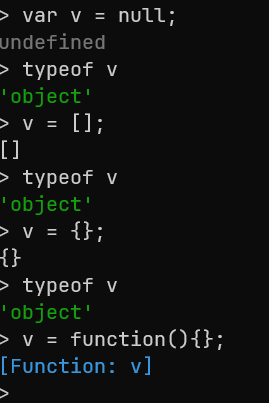Deep Dive JS
JavaScript

Tags: Advance, Frontend, Interview Resources: https://frontendmasters.com/courses/deep-javascript-v3
1. Types
Primitive Types:
-
string
-
number
-
boolean
-
object
-
symbol
-
undefined
-
bigint
-
undeclared?
-
null?
-
function?
-
array?
All are subtype of Object type.

NaN and isNaN
NaN (
not a number) is a Invalid Number.
var a = Number("n/a")
console.log(a) // NaN
console.log( a === a) // false
2. Coercion
Coercion is a type conversion
Number
It coercion the object value to String first.
// Corner case:
Number("n") // NaN
Number("-0") // -0
Special case:
0 === -0is true because they are considered numerically equal.NaN !== NaN
Boolean
Has a lookup table to defined for falsy and truthy values (NO type coercion here),
Boxing
- Implicit coercion, example:
.toString()on number (primitive value), means able to use properties of an object on primitive values. - Boxing is a feature why, people say “In JS, everything is an object” but, if something behaves like an object **doesn’**t make it an Object.
Summary:
Negative zero and empty string to number coercion are base of all (most) of evil.
No TypeScript?
3. Equality
Why == and === ? what’s difference?
Triple Equals
- If type of operands are different return false
- If type is Number check for special case:
- NaN is NOT equals to itself.
- -0 (negative zero) is equal to +0 (normal zero) and vice-versa.
Double Equals
Double Equals prefers Numeric coercions
- if type of the operands are same then, itself calls the triple equals
- If null or undefined: equals
- If non-primitives: calls
ToPrimitive - Prefers:
ToNumber
Avoid Double Equals
- == with 0 or “”
- == with non-primitives
- ==
trueor ==false. Just allowToBooleanor use ===
4. Static Typing
Popular static typing language are TypeScript by Microsoft and not so popular Flow by Facebook.
Cons:
- Non-JS-standard, one day when JavaScript decides to add typing , it may not be same as Typescript.
- Require a build process
- Complexity
5. Scope
Scope: Where to look for things (identifiers) in program.
-
JavaScript is an interpreted-language? (reads code line-by-line from top-down)
Let say we have 10 lines of code and we have syntax error on line 10. What happens? Code at line 1-9 also doesn’t run, that means there is a additional step before the JS Engine reads code line-by-line, lets call it Parsing. (Learn Complier theory for details).
Auto Create Global Variable ⁉️
When a variable is assigned but not declared in current scope, it keeps going back until global scope is reached.
When a variable is assigned but not declared, JS auto declares a variable at global scope 🤮.
This happens at Runtime and not compile time.
Example:
function sayHi(){
name = "alex" // NOT declared, but JS will auto declare it in global scope.
console.log(name)
}
sayHi()
How to avoid?
By using use strict directive, this will not allow auto global. It will throw a reference error.
undefined vs undeclared
undefined means a variable is declared but doesn’t have any value, so it defaults to undefined
undeclared means a variable is not even declared, throws a reference error.
Function Expression
function func1() {} // Function declaration
// Function expression with named function
const myFunc = function func2(){ /*do something*/}
// Function expression with anonymous function
const myFunc2 = function (){ /*do something*/}
Function Declaration attach their scope to parent block.
Function Expression attach their scope to itself and NOT parent.
6. Scope (Advance)
Lexical Scope
The idea of nested scope and compiler/parser figuring out the scope before execution.
Hoisting
Hoisting is made-up metaphor for lexical scope. JavaScript do not do Hoisting. If you understand the lexical Scope, let play it out
x = 3;
var x;
Consider the above code, so called hoisting is nothing but, the compiler(parser) doing the lexical scope. It means the compiler asks the scope manager, ‘’we have a use of variable x does that exists int the scope?’’
let doesn’t hoist - FALSE
let , const and var all Hoist. but there is how they are hoisted.
When var is hoisted, it say to a create a variable and initialize it to undefined.
When let and const are hoisted, they say, create a variable and do NOT initialize.
let, const, var
let and const are block scoped
var is function scoped.